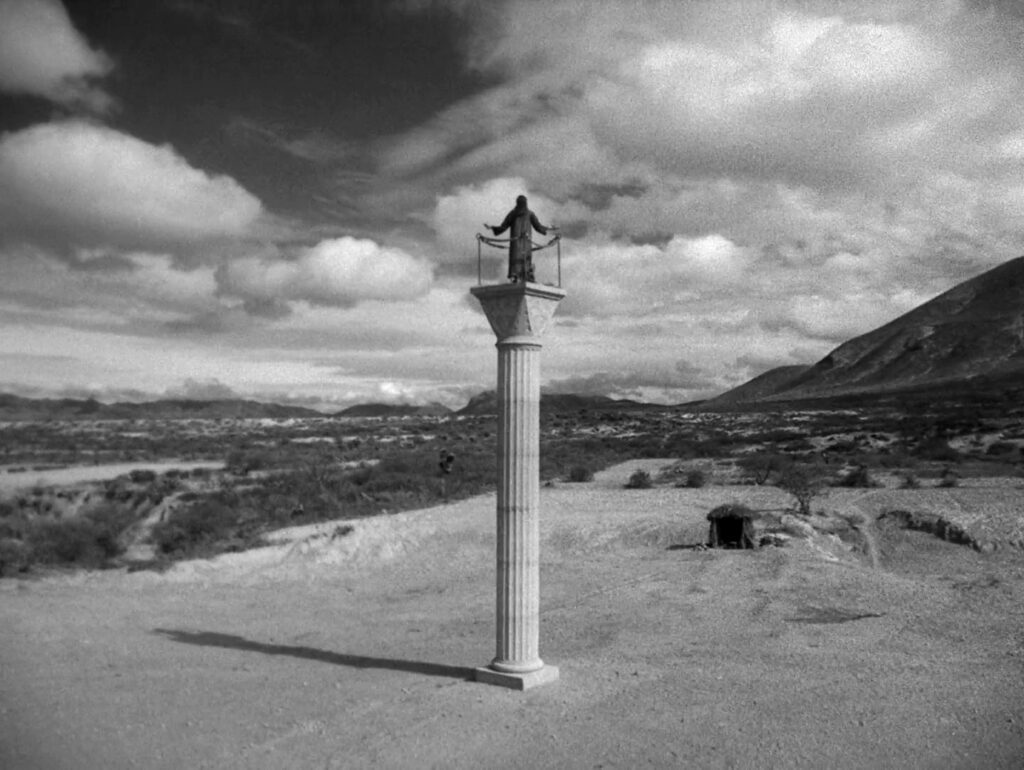
Simón of the Desert
1965, directed by Luis Buñuel
After spending forty minutes with a saintly hermit in the Mexican desert, Simón of the Desert ends with a shock. It’s not just that Satan finally succeeds in tempting him. Despite all of his resistance, she’s had her claws in his soul from the outset. Buñuel’s satire is strong enough that we could always detect a weakness in Simón, from the moment he allows a wealthy patron to honor him with a more extravagant column. The shock, rather, is the abrupt leap from the desert to Manhattan. Simón’s column stands in an environment scarcely different from that of his 5th century namesake, St. Simeon Stylites, who spent 37 years atop a column in Syria. The nightclub, on the other hand, barely looks dated six decades after the film was made.
The dance floor looks commonplace today, as it also would have looked in the mid-1960s, but at least back then there were older generations who still found the style of dance alarming. Buñuel belonged to one of those generations, but he was no prude, and he probably wouldn’t have taken exception to the dancers’ primitive energy. From his avant-garde youth to his old age he was always a firebrand who delighted in shocking friends and enemies alike. Nevertheless there’s one quality in the dance that’s consistent with Simón’s penance on top of the column.
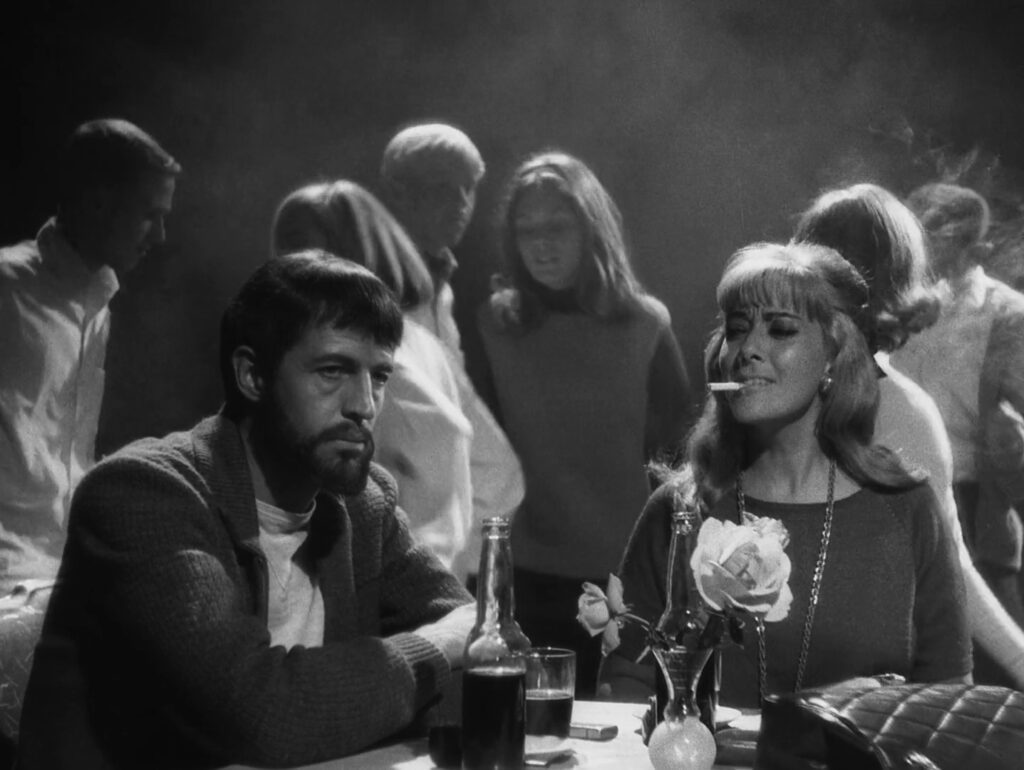
Satan tells Simón the dance is called “Radioactive Flesh”. The name befits the dancers’ energy, but it also calls attention to something we’re unlikely to remark on today. The dancers almost never touch each other. Each individual is like a free-floating atom, showing off privately, as if everyone else were radioactive and dangerous to touch. Until the rock & roll era most dancing was either synchronized (e.g. folk dances), coordinated (ballet), or put the dancers in physical contact (ballroom dancing). On this dance floor, just like Simón on his pillar or like the bourgeois partygoers in The Exterminating Angel, there’s a pronounced separation between members of society.
Buñuel makes film after film on variations of this idea, always preoccupied with the inability or unwillingness of people to come together. Forces of detachment separate people from each other, precluding not only cooperation and intimacy but any kind of honest social interaction. Detachment perpetuates social hierarchies, and it diminishes the potential for happiness.
The image of Simón on his column, mortifying himself while also standing above humanity, is such an iconic picture of detachment that it comes dangerously close to saying everything the film has to say. The column puts Simón symbolically closer to God, but in a proud and conspicuous way, and its more immediate effect is to distance him from the people below. It’s a self-imposed prison but also a pedestal aggrandizing him. Simón insists he’s unworthy of the priesthood, but he declines holy orders with an ostentatious show of humility. The film revels in these paradoxes, and it justifies its modest length with incidents that poke fun at the extent of detachment in religious piety.
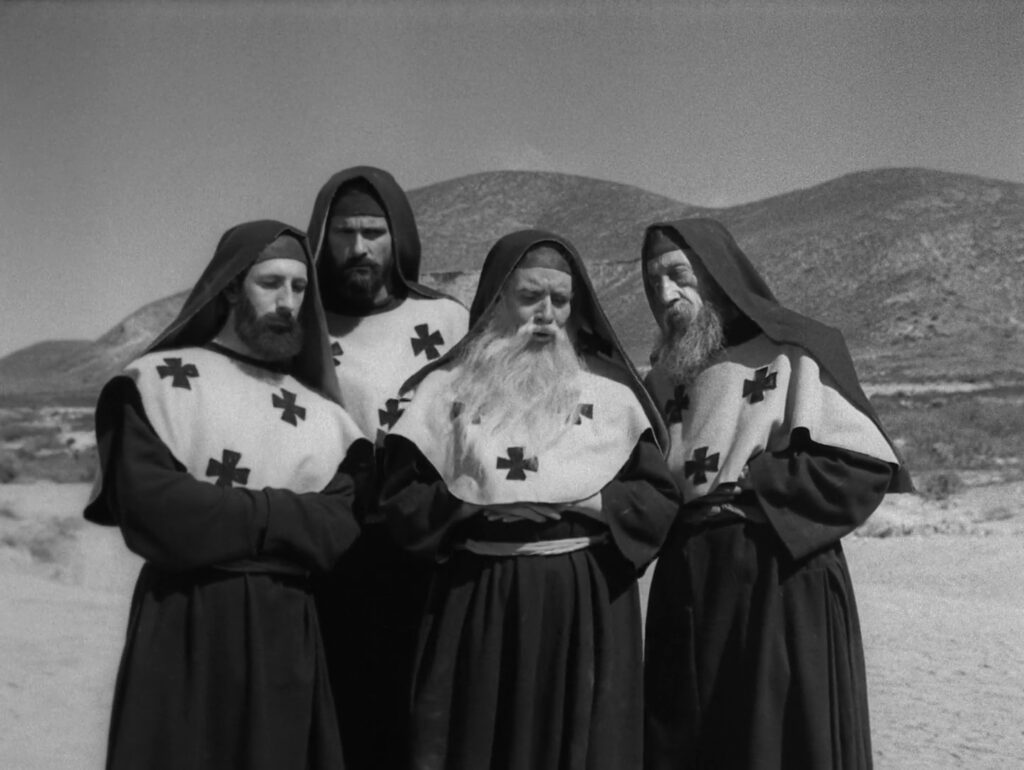
Simón of the Desert opens with a parade of monks and devotees walking toward Simón’s column. At first glance they seem united in purpose and in spirit. They’re singing a pilgrim’s hymn, and they’re moving in unison to a common destination. A herd of goats crosses their path, hinting at the satire to come. Buñuel seemed to love images of people or livestock walking in apparent harmony: the pilgrims in The Milky Way, the characters walking down the road in The Discreet Charm of the Bourgeoisie, the sheep in The Exterminating Angel which mirror the human characters so unflatteringly. In each case, and again here, he punctures the image of harmony, exposing an atomized group of self-concerned individuals. Everyone’s sincerity proves to be a facade.
Simón’s new column is the gift of a wealthy man cured of an “unspeakable disease” (one imagines syphilis). In return he puts Simón atop a column about twice as high, which would doubtless make the hermit’s life more uncomfortable. Nevertheless the patron is a benefactor in the crowd’s eyes. On his way to his new perch, Simón cruelly renounces contact with his mother, telling her they can speak in the next life. Before the crowd disperses, Simón performs a miracle, restoring the hands of an amputee. Instead of awe and gratitude, the man uses his new hands to swipe the back of his daughter’s head, and a pair of monks walks away unimpressed: “See that?” “What?” “That thing with the hands.” “Oh, that. Any bread left?” These reactions might seem overly cynical, but the film is merely skipping the obligatory surprise to show how quickly people revert to their petty concerns after beholding something extraordinary.
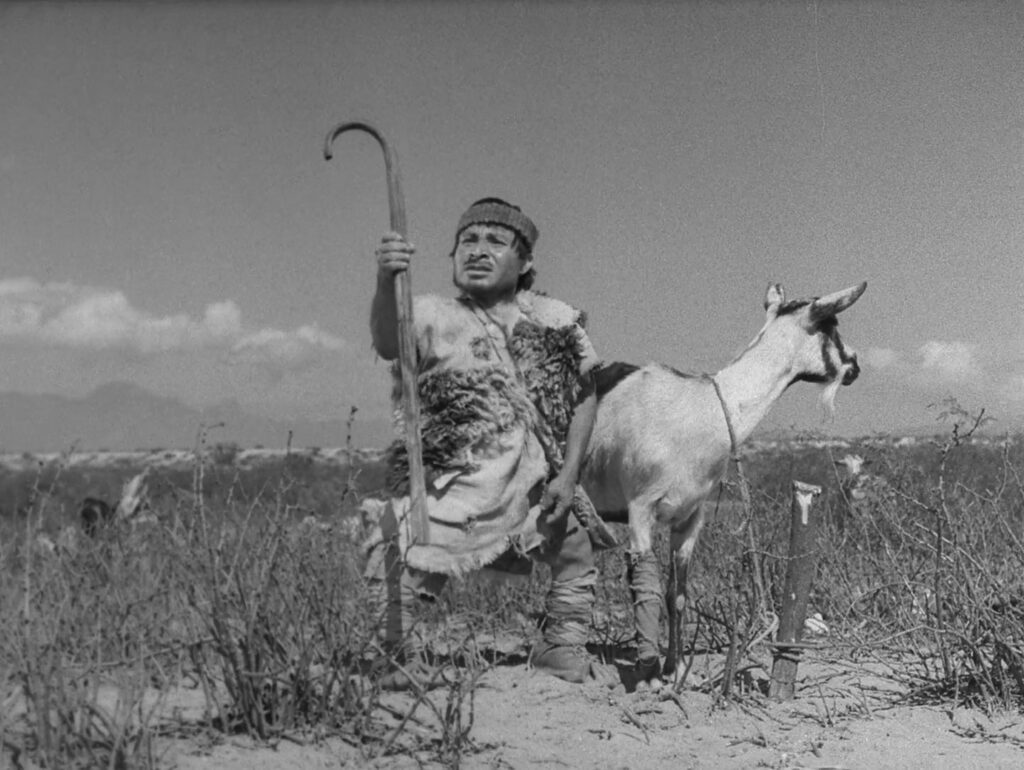
The film’s incidents illustrate each of the seven cardinal vices and seven capital virtues. The vices are genuine enough… Brother Trifón plants delicacies in Simón’s bag out of envy; one of the monks looks on the Devil’s female form with lust; and Simón calls Brother Matias an “idiot” and a “conceited ass”. Each time Simón displays virtue, however, he widens a gulf between himself and society. His temperance, charity, patience, and chastity are all occasions for displaying superiority. After declaring Trifón’s slander to be sweeter than praise, he proceeds to exorcize the Devil from his accuser. Not to be outdone, the head priest adds, “I’ll finish exorcizing him at the monastery in my own way.” Simón’s chastity is a thin mask for his misogyny, and his fasting is one of many occasions for pride.
With his arms spread wide in prayer atop the column, Simón resembles the crucified Christ, but the first line of dialogue undermines the tone of reverence. A monk tells Simón, “For six years, six weeks, and six days you’ve stood on that column.” The three sixes are the number of the Beast from Revelation 13:18. If the movie showed any sign of religious sincerity we might take this as the mark of a false prophet, but the film reflects Buñuel’s impish atheism all too clearly. The point is not that Simón perverts Christ’s teachings, but rather that Christianity itself is hopelessly at odds with itself. It pretends to bring people together in community, but its emphasis on virtue and sin gives its adherents too much occasion to set themselves apart from each other. Prayer, asceticism, penance, and charity all have the effect of debasing neighborly love.
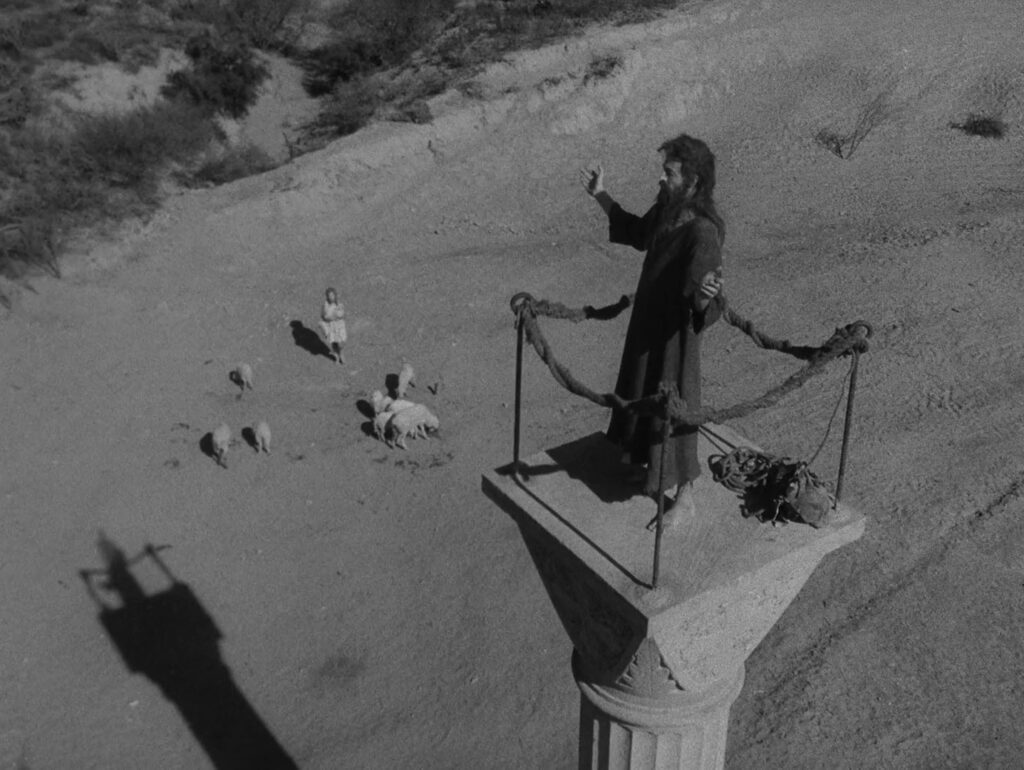
Buñuel was a lifelong leftist who joined the Spanish Communist Party in 1931 but later denied being a communist. In any case his consistent critique of detachment shows that he took the root word of communism, i.e. “community”, as an ideal. The hypocrisy in Simón of the Desert is opposite both to the spirit of communism and to the communion of souls that Christianity aspires to, and detachment is precisely what hinders the realization of both those ideals.
Early in his career Buñuel was associated with the Surrealist movement, and his later films carry on something of the surrealist spirit. Surrealism suits Buñuel’s purpose because it tends to show an object as detached and connected at the same time. Dalí’s melted watches are simultaneously detached from their purpose (they droop like hot wax) and connected to it (they still seem to register the time), and the severed hand in The Exterminating Angel fits the schema too, being both detached and alive. A similar duality runs through all of the strangeness and hypocrisy in Simón of the Desert, but one way or another it’s always the detachment that comes out on top. A coffin is an image of death, but what catches our attention is its self-propelled movement across the desert. Simón and the monks go through the motions of holiness, but we’re left with a sense of their iniquity.
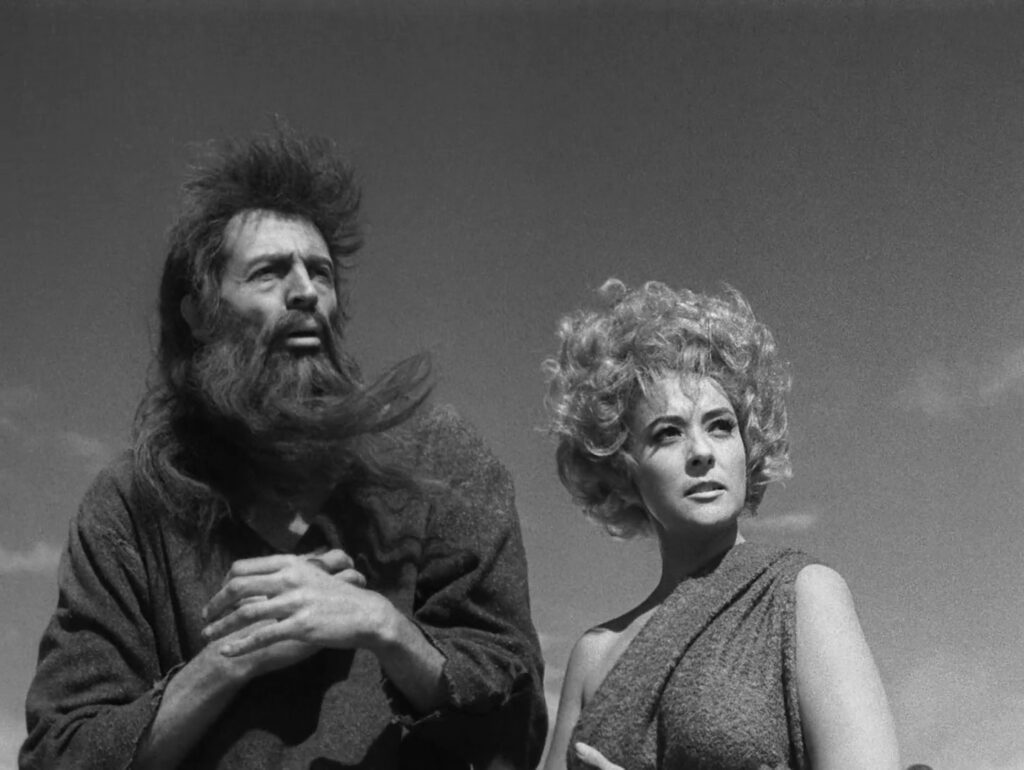
It’s another surreal touch when the airplane whisks Simón and his tempter to New York, from a biblical landscape to a modern one… but there’s a strong continuity between the two worlds. Detachment dominates in both, and Simón simply swings from one extreme to another as fanatics are liable to do. Having seduced her victim and won his soul, Satan has no further use for him, and she goes off to dance with another man, telling Simón he’d better not go home because “Another tenant’s moved in.” The fitting end to all of his detachment is that he’s separated from the one person he wants, and either left all alone or forced to share quarters with someone he doesn’t want.
CONNECTIONS:
Earth – Airplane near the end resembling a secular version of the Holy Cross
The Exterminating Angel – Illustration of detachment and its effects; abrupt and ironic twist at the end
Winter Light – Critique of religion’s failure to achieve its ideal of communion
Zabriskie Point – Begins and ends with atomized groups of individuals